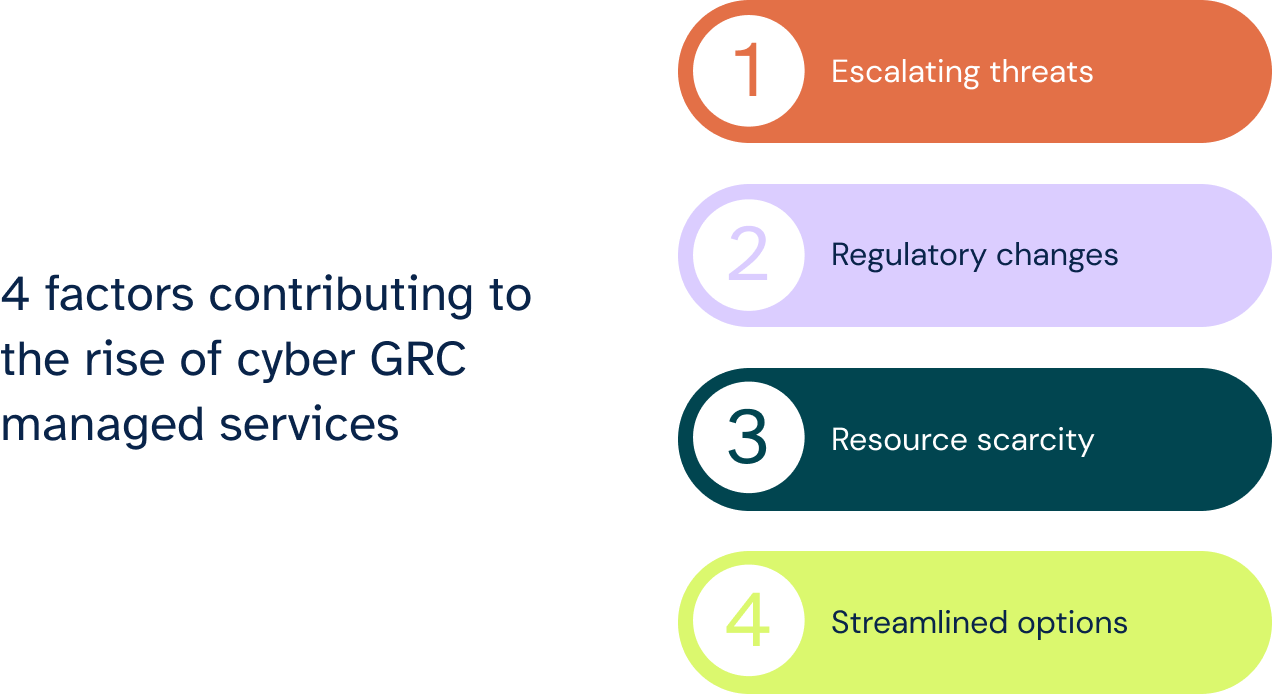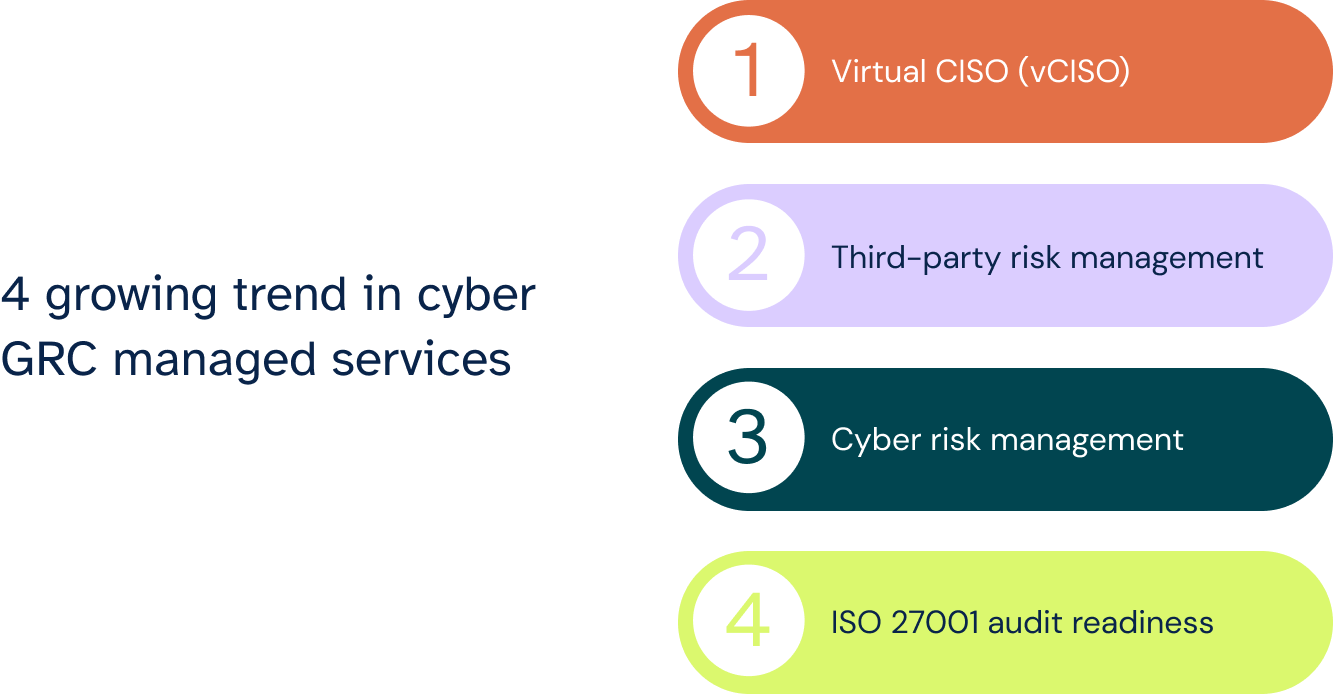As digital transformation accelerates, organizations struggle with intensifying cyber threats and more stringent regulatory compliance. According to IBM's Cost of a Data Breach Report 2023, cyber attacks now cost companies an average of $4.45 million, a 15% increase over three years. Many organizations are turning to managed cyber GRC services to manage these challenges.
Cyber GRC combines critical security, risk, and compliance functions into one. It provides a holistic view of cyber exposures and compliance obligations. However, designing, implementing, and operating a cyber GRC program requires substantial expertise and resources. That drives the increasing demand for cyber GRC managed services tailored to an organization's needs.
According to recent projections, the managed cybersecurity services market will grow at a 16.11% CAGR through 2029, reaching $76.09 billion globally. Cyber GRC services are a major contributor, providing integrated risk and compliance coverage not included in general MSSP offerings.
By leveraging managed cyber GRC services, organizations can efficiently align security, risk management, and compliance. That reduces technology and staffing costs while providing access to specialized skills to navigate today's threat landscape. As cyber risks become more prevalent, reliance on managed cyber GRC experts will continue growing.
Join us as we dive into the growing trend and need for cyber GRC managed services and how innovative software solutions can provide support.

The increasing demand for cyber GRC managed services
The digital age has brought incredible opportunities and a darker side: a rapidly evolving threat landscape filled with sophisticated cyberattacks, stringent compliance mandates, and the constant pressure to demonstrate robust risk management.
In this unstable environment, organizations increasingly turn to one crucial component: cyber GRC managed services. The demand for these services is surging due to numerous factors:
- Escalating threats: Ransomware, zero-day exploits, and targeted attacks are becoming common, demanding specialized expertise and vigilance. Gartner predicts global security spending to exceed $262 billion by 2023, highlighting the immense scale of the problem.
- Regulatory changes: The regulatory landscape is filled with new and emerging laws. Keeping pace with these changing regulations requires dedicated resources and specialized knowledge, often exceeding the internal capabilities of many organizations.
- Resource scarcity: Building and maintaining a skilled in-house GRC team is expensive and time-consuming. Cybersecurity professionals are in high demand and short supply, making it a constant struggle to recruit and retain the necessary talent.
- Streamlined operations: With these complexities swirling around them, organizations now realize the value of focusing their resources on their core business strengths. Outsourcing non-core functions like cyber GRC frees internal resources, optimizes costs, and improves overall agility.
To overcome these challenges, organizations now rely on cyber GRC MSPs offering comprehensive services, including:
- vCISO: A remote, expert cybersecurity consultant providing the same strategic guidance as an in-house Chief Information Security Officer.
- Risk assessment and management: Identifying and mitigating vulnerabilities across IT infrastructure, data, and applications.
- Compliance management and audit readiness: Ensuring adherence to relevant regulations and streamlining compliance processes.
- Threat detection and response: Continuous threat monitoring, prompt incident response, and forensic analysis.
- Reporting and analytics: Providing actionable insights into risk posture and compliance performance.
- Third-party risk management: Mitigating potential threats by analyzing and minimizing the risks of relying on external vendors and service providers.
The rise of cyber GRC managed services presents challenges and opportunities for traditional GRC software vendors. While some may see it as a threat to their market share, others embrace the opportunity to partner with MSPs and integrate their software solutions into managed service offerings. This collaboration can unlock new revenue streams and expand reach to a broader customer base.
The demand for cyber GRC managed services is poised for continued growth. Organizations of all sizes now recognize the value of outsourcing this critical function to specialized providers. For GRC software vendors, the key lies in adapting their offerings to cater to the MSP ecosystem and capitalizing on the synergies created by this dynamic collaboration.
The opportunity for MSPs and advisory firms
Managed service providers (MSPs) and technology advisory firms are uniquely positioned to capitalize on the growing demand for cyber GRC services. This sector presents numerous opportunities, particularly in assisting organizations that seek expertise in managing complex GRC programs. Let's delve into the specifics:
Meeting the demand for cyber GRC management
Many organizations, especially small to medium-sized enterprises (SMEs), struggle with implementing and managing an effective cyber GRC program due to advancing cyber threats and the intricacies of compliance regulations. MSPs and advisory firms can fill this gap, offering specialized skills and strategic methodologies that are often absent in-house. By doing so, they address a critical market need, helping organizations fortify their cybersecurity posture and ensure compliance with regulatory standards.
Specialized skills and methodologies
The cyber GRC domain requires a blend of technical expertise and regulatory knowledge. MSPs and advisory firms can leverage their specialized cybersecurity, risk assessment, and compliance management skills to provide tailored solutions.
This expertise, combined with proprietary risk and compliance management methodologies, can significantly benefit clients who lack the resources or knowledge to manage these aspects internally.
Monthly recurring revenue model
Cyber GRC services lend themselves well to a monthly recurring revenue (MRR) model. This model benefits MSPs and advisory firms by providing predictable, stable income while offering clients cost-effective, ongoing support. The MRR model aligns with the continuous nature of cyber risk management and compliance, fostering long-term client relationships.
Ability to scale services to client needs
One significant advantage of MSPs and advisory firms is the ability to scale services according to client needs. MSPs can tailor their offerings for a small business that requires basic compliance assistance or a larger enterprise that needs a comprehensive cyber GRC strategy. This scalability not only makes services accessible to a broader client base but also enables providers to adjust their support as client needs evolve.
Competitive differentiation in the crowded MSP market
The MSP market is increasingly competitive. Offering cyber GRC services can be a key differentiator. This specialization allows MSPs and advisory firms to stand out, showcasing their expertise in a critical and growing field. By focusing on cyber GRC, providers can position themselves as leaders in a niche yet essential area, distinguishing their services from more generalized IT support offerings.
The growing cyber GRC market presents significant opportunities for MSPs and advisory firms. From meeting the growing demand for GRC management to providing specialized skills, adopting a monthly recurring revenue model, scaling services, and differentiating competitively, the sector is ripe with potential.
By capitalizing on these opportunities, MSPs and advisory firms can expand their business and play a pivotal role in enhancing their clients' cyber resilience.

Key cyber GRC managed services
In today's digital landscape, ensuring robust cybersecurity, effective risk management, and unwavering compliance is monumental. That is where cyber GRC managed services — your trusted partner in building a secure and compliant foundation for your organization — come in. Let’s explore the essential services designed to streamline processes and empower you to thrive despite advancing threats.
Virtual CISO (vCISO)
A Virtual CISO (vCISO) is a seasoned cybersecurity professional who provides strategic security guidance and oversight on a remote, on-demand basis. They act as a trusted advisor, filling the gap for organizations that lack the resources or budget for a full-time, in-house Chief Information Security Officer (CISO). vCISOs play a multifaceted role, acting as trusted advisors, strategic leaders, and hands-on security experts.
Here's a closer look at the key roles they play:
Security advisors
vCISOs develop and implement comprehensive cybersecurity strategies aligned with the enterprise's business goals and risk tolerance. They also objectively assess the existing security posture, identifying vulnerabilities and potential threats. They also recommend and prioritize security investments and resource allocation based on risk assessments and ROI considerations.
vCISOs also foster a culture of security awareness within the organization through training programs, awareness campaigns, and incident response simulations.
Security educators
vCISOs develop tailored cybersecurity training programs for employees, catering to their specific roles and responsibilities. They also design targeted programs for phishing awareness, password hygiene, and social engineering tactics. vCISOs also encourage open communication about security concerns, empowering employees to report suspicious activity and ask questions without fear of judgment.
Security experts
vCISOs continuously monitor and analyze threat intelligence feeds and industry trends to stay ahead of emerging threats and vulnerabilities. They also conduct regular assessments and penetration testing to identify IT system and network vulnerabilities. Prioritizing and remediating vulnerabilities based on risk assessment and potential impact, focusing on critical systems and data is also part of their responsibilities.
vCISOs also develop and implement threat-hunting strategies to proactively identify and neutralize malicious activity within the network.
To summarize, a VCISO can be a valuable asset for any organization that wants to improve its cybersecurity posture and protect its data.
Third-party risk management
Third-party risk management (TPRM) is a critical business process for mitigating risks associated with relationships with external partners, primarily vendors, suppliers, contractors, and service providers. It also helps organizations understand and manage the security, privacy, compliance, and operational risks these third parties pose. TPRM often involves:
- Identifying critical third parties: Not all vendors pose the same risk levels. TPRM involves assessing dependencies and prioritizing third parties based on their access to sensitive data and systems and impact on critical business functions.
- Risk assessment and due diligence: This involves evaluating your third parties' security posture, compliance practices, and operational resilience. It often includes questionnaires, on-site visits, and security audits.
- Monitoring and continuous evaluation: Threats constantly change, so monitoring third-party performance and potential threats is crucial. That can involve automated tools, regular reviews, and incident response exercises.
- Contractual clauses and risk mitigation: Contracts should clearly define both parties' security expectations and responsibilities. Additionally, mitigation strategies like data encryption, access controls, and incident response plans should be implemented.
Cyber risk management
Cyber risk management is the proactive and ongoing process of identifying, assessing, and mitigating the security threats to your information systems and data. Here's a look into the key aspects of cyber risk management:
- Identifying threats: This involves understanding the attacks that could target your organization, such as malware, phishing, ransomware, and data breaches. It also includes assessing system vulnerabilities that attackers could exploit.
- Assessing risks: Once you know the threats, you must evaluate their likelihood and potential impact. A minor inconvenience caused by a website phishing attack differs from a complete data breach that could affect your business. Prioritizing risks based on this assessment helps you focus your resources on the most pressing issues.
- Mitigating risks: This is where you implement controls and safeguards to prevent or minimize the impact of cyberattacks. Some common tactics are:
-
- Installing firewalls, intrusion detection systems, and antivirus software.
- Implementing strong passwords, user authentication, and data encryption.
- Educating employees about cybersecurity best practices and incident response procedures.
- Regularly updating your software and systems to fix security flaws.
- Having a plan for responding to a cyberattack if it does occur.
- Monitoring and continuous improvement: Cyber risk management is not a one-time thing. You must monitor your systems for suspicious activity and update your controls and strategies.
ISO 27001 audit readiness
An ISO 27001 audit readiness is the process of preparing your organization for an external audit to assess your compliance with the ISO 27001 Information Security Management System (ISMS) standard. That involves various processes that ensure your organization's information security practices and controls align with the standard's requirements, leading to a smooth and successful audit experience.
Here's what ISO 27001 audit readiness entails:
- Understanding the standard: Familiarizing yourself with the ISO 27001 requirements, including Annex A controls, helps you identify relevant areas to assess and improve.
- Gap analysis: Conducting a thorough assessment of your security posture helps you identify any shortcomings or gaps in your existing controls compared to the ISO 27001 standard.
- Documentation and evidence: Preparing documentation showcasing your ISMS policies, procedures, risk assessments, and implemented controls demonstrates your understanding and adherence to the standard.
- Mock audits: Conducting internal audits simulating the external audit process helps identify weaknesses, train personnel, and refine your documentation before the audit.
- Remediation and improvement: Addressing identified gaps through corrective actions, implementing missing controls, and enhancing existing practices strengthen your security posture.
- Training and awareness: Ensuring employees understand their roles and responsibilities in adhering to security policies and procedures fosters a culture of information security.
- Management review: Engaging top management in reviewing your ISMS effectiveness and providing necessary resources demonstrates buy-in and commitment to achieving certification.
ISO 27001 audit readiness is not just about passing the audit; it's about building a robust and sustainable information security management system that protects your organization's valuable data and assets. However, ISO 27001 audit readiness is just one standard. In cybersecurity, you can find other similar approaches, depending on industry and location.
Take the next step with 6clicks
Modern enterprises face complex cybersecurity risks, compliance mandates, and governance requirements. Managing these internally can be resource-intensive, requiring specialized expertise and ongoing effort. That is where cyber GRC managed services come in, offering a holistic approach to managing governance, risk, and compliance through outsourced expertise and tech.
6clicks' approach to cyber GRC:
- Integrated platform: Our platform integrates GRC functionalities across various domains, including IT security, data privacy, third-party risk, and regulatory compliance. This comprehensive approach streamlines GRC efforts, promoting greater efficiency and visibility.
- AI-powered automation: We use AI to automate time-consuming tasks like policy and compliance management, audited and assessment response and reporting. That frees up internal resources for higher-level strategic activities and enhances the overall effectiveness of GRC programs.
- Scalability and adaptability: We understand that organizational needs are evolving. We design solutions to scale with your growth, adapting to your size, industry, and specific risk landscape.
- Centralized management: Our Hub & Spoke is a unique architecture designed for organizations with distributed risk and compliance functions across multiple teams, departments, or businesses. It allows organizations to centralize control while empowering individual units with autonomy.
- Combined resources: Our content library is a one-stop shop for risk and compliance content, readily available to users on every license type. It boasts vast resources, including standards, regulations, frameworks, audit and assessment templates, and more.
Experience a demonstration of how our AI-powered platform for cyber risk and compliance can help you.
6clicks presents a compelling option for enterprises seeking to leverage the growing potential of cyber GRC managed services. Our comprehensive platform, AI-powered features, and expert services address key areas while offering cost-effectiveness and resource optimization.
If you’re interested in partnering with 6clicks to provide your clients with AI-powered cyber GRC services and unlock new revenue opportunities, then please contact us below. We look forward to chatting with you.
Written by Louis Strauss
Louis is the Co-founder and Chief Product Marketing Officer (CPMO) at 6clicks, where he spearheads collaboration among product, marketing, engineering, and sales teams. With a deep-seated passion for innovation, Louis drives the development of elegant AI-powered solutions tailored to address the intricate challenges CISOs, InfoSec teams, and GRC professionals face. Beyond cyber GRC, Louis enjoys reading and spending time with his friends and family.





